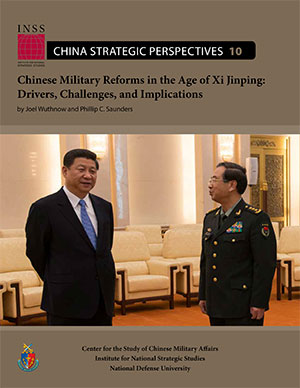DOWNLOAD PDF
 Executive Summary
Executive Summary
China’s People’s Liberation Army (PLA) has embarked on its most wide-ranging and ambitious
restructuring since 1949, including major changes to most of its key organizations.
- The general departments were disbanded, new Central Military Commission (CMC)
departments created, and a new ground force headquarters established.
- Seven military regions were restructured into five theater commands aligned against
regional threats. Commanders will be able to develop joint force packages from army,
navy, air force, and conventional missile units within their theaters.
- PLA service headquarters are transitioning to an exclusive focus on “organize, train,
and equip” missions and will no longer have a primary role in conducting operations.
However, the PLA is still figuring out how the new relationships among the CMC, services,
and theaters will work in practice.
The restructuring will also reduce the size of the PLA by 300,000 soldiers, cutting the
ground forces and increasing the size of the navy and air force.
The restructuring reflects the desire to strengthen PLA joint operations capabilities—on
land, at sea, in the air, and in the space and cyber domains.
- The centerpiece of the reforms is a new joint command and control structure with
nodes at the CMC and theater levels that will coordinate China’s responses to regional
crises and conduct preparations for wartime operations.
- A Strategic Support Force has been established to provide command, control, communications,
computers, intelligence, surveillance, and reconnaissance support to commanders
and will oversee space, cyber, and electronic warfare activities. A Joint Logistics
Support Force will provide logistics support to units within the theaters.
- The creation of a joint command system complements other recent changes supporting
joint operations—including joint training, logistics, and doctrinal development.
The reforms could result in a more adept joint warfighting force, though the PLA will continue
to face a number of key hurdles to effective joint operations.
- If the reforms are successful, the PLA could field a joint force more capable of undertaking
operations along the contingency spectrum, including high-end operations against
the U.S. military, allied forces in the Western Pacific, and Taiwan.
- Key obstacles include continued ground force dominance, interservice rivalry at a time
of slowing budget growth, and lack of combat experience for most PLA personnel.
- Several years of joint exercises and training will be needed for PLA officers and units to
gain experience in operating under the new system. This could impede China’s ability to
conduct major combat operations during this period.
Several potential actions would indicate that the PLA is overcoming obstacles to a stronger
joint operations capability.
- Useful indicators of progress would include more joint assignments going to non–
ground force officers, expansion and deepening of joint training, and evidence that the
theater commands are exercising operational control over air, naval, and conventional
rocket forces.
- Additional reforms to the officer assignment and military education systems will be announced
in 2017, and will play a critical role in cultivating the military leaders necessary
to conduct effective joint operations in a restructured PLA.
The reforms are also intended to increase Chairman Xi Jinping’s control over the PLA and
to reinvigorate Chinese Communist Party (CCP) organs within the military.
- The reforms emphasize Xi’s role in making all major decisions, reversing the delegation
of authority to the two vice chairmen under Hu Jintao. However, Xi will still have to rely
on trusted agents within the PLA to supply military advice and execute decisions.
- The restructuring strengthens supervision of the military by giving auditing, discipline
inspection, and military legal mechanisms more independence and having them report
directly to the CMC.
- Xi is also trying to increase ideological control by emphasizing the importance of political
work and the military’s “absolute obedience” to the Party.
Xi Jinping’s ability to push through the reforms indicates that he has more authority over
the PLA than his recent predecessors.
- Xi has been able to wield sticks and carrots to break the logjam of institutional and
personal interests that stymied previous reform efforts.
- The ultimate effectiveness of efforts to strengthen CCP control will depend on Xi’s ability
to devote sufficient attention to supervising the military and on the loyalty of the officers
who will implement the control mechanisms.
- If Xi’s leadership falters or if a slowing Chinese economy can no longer provide resources
for military modernization, PLA leaders may grow dissatisfied with Xi’s efforts to
strengthen CCP control over military affairs and to emphasize political ideology.
The restructuring could create new opportunities for U.S.-China military contacts.
- The PLA now has closer counterpart positions for some senior U.S. billets, such as Chief
of Staff of the Army. This could provide an opportunity for more productive exchanges.
- The creation of a new joint command system and the role of the theater commanders
in directing operations will require adjustments to existing confidence-building and communications
measures to ensure that U.S. and Chinese forces can communicate effectively
during a crisis.
READ MORE >>